ASUS A88X-Pro Review: Kaveri, Kaveri, Quite Contrary
by Ian Cutress on April 22, 2014 11:59 AM EST- Posted in
- Motherboards
- AMD
- Asus
- Kaveri
Real World CPU Benchmarks
Readers of our motherboard review section will have noted the trend in modern motherboards to implement a form of MultiCore Enhancement / Acceleration / Turbo (read our report here) on their motherboards. This does several things – better benchmark results at stock settings (not entirely needed if overclocking is an end-user goal), at the expense of heat and temperature, but also gives in essence an automatic overclock which may be against what the user wants. Our testing methodology is ‘out-of-the-box’, with the latest public BIOS installed and XMP enabled, and thus subject to the whims of this feature. It is ultimately up to the motherboard manufacturer to take this risk – and manufacturers taking risks in the setup is something they do on every product (think C-state settings, USB priority, DPC Latency / monitoring priority, memory subtimings at JEDEC). Processor speed change is part of that risk which is clearly visible, and ultimately if no overclocking is planned, some motherboards will affect how fast that shiny new processor goes and can be an important factor in the purchase.
As far as we could determine, the ASUS A88X-Pro did implement a form of Multi-Core Turbo given some of the results in multithreaded workloads.
Rendering – Adobe After Effects CS6: link
Published by Adobe, After Effects is a digital motion graphics, visual effects and compositing software package used in the post-production process of filmmaking and television production. For our benchmark we downloaded a common scene in use on the AE forums for benchmarks and placed it under our own circumstances for a repeatable benchmark. We generate 152 frames of the scene and present the time to do so based purely on CPU calculations.
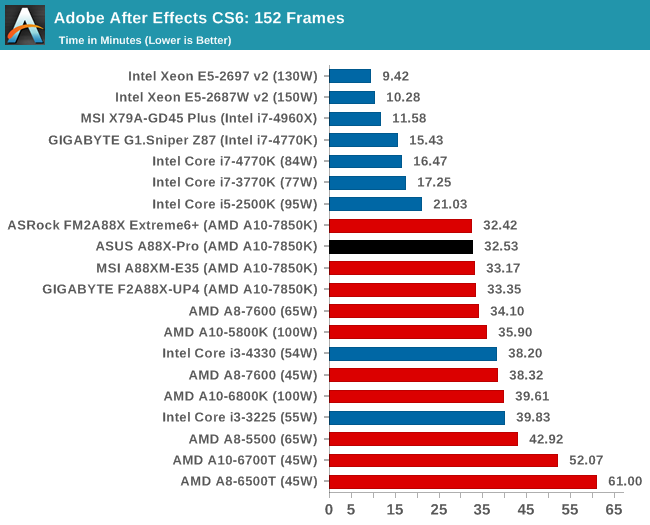
Compression – WinRAR 5.0.1: link
Our WinRAR test from 2013 is updated to the latest version of WinRAR at the start of 2014. We compress a set of 2867 files across 320 folders totaling 1.52 GB in size – 95% of these files are small typical website files, and the rest (90% of the size) are small 30 second 720p videos.
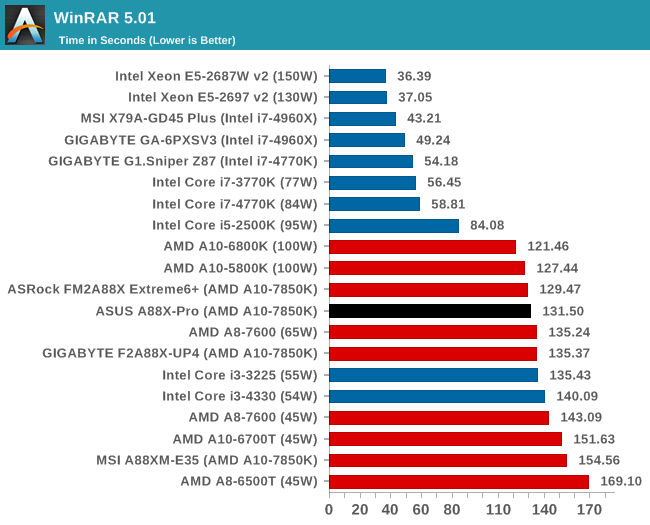
Image Manipulation – FastStone Image Viewer 4.9: link
Similarly to WinRAR, the FastStone test us updated for 2014 to the latest version. FastStone is the program I use to perform quick or bulk actions on images, such as resizing, adjusting for color and cropping. In our test we take a series of 170 images in various sizes and formats and convert them all into 640x480 .gif files, maintaining the aspect ratio. FastStone does not use multithreading for this test, and thus single threaded performance is often the winner.
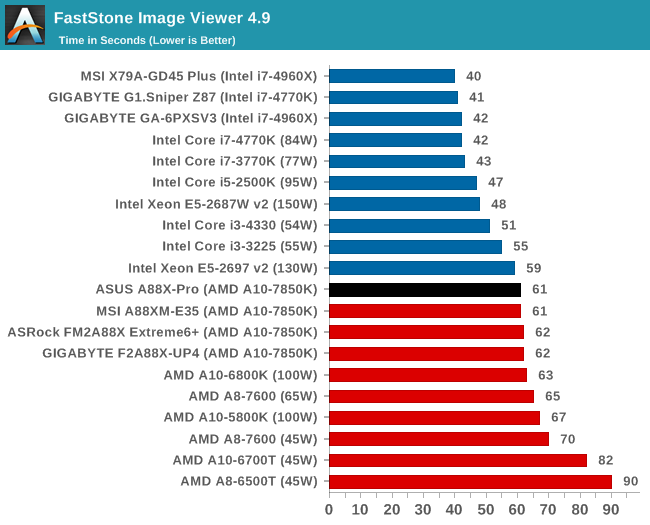
Video Conversion – Xilisoft Video Converter 7: link
The XVC test I normally do is updated to the full version of the software, and this time a different test as well. Here we take two different videos: a double UHD (3840x4320) clip of 10 minutes and a 640x266 DVD rip of a 2h20 film and convert both to iPod suitable formats. The reasoning here is simple – when frames are small enough to fit into memory, the algorithm has more chance to apply work between threads and process the video quicker. Results shown are in seconds and time taken to encode.
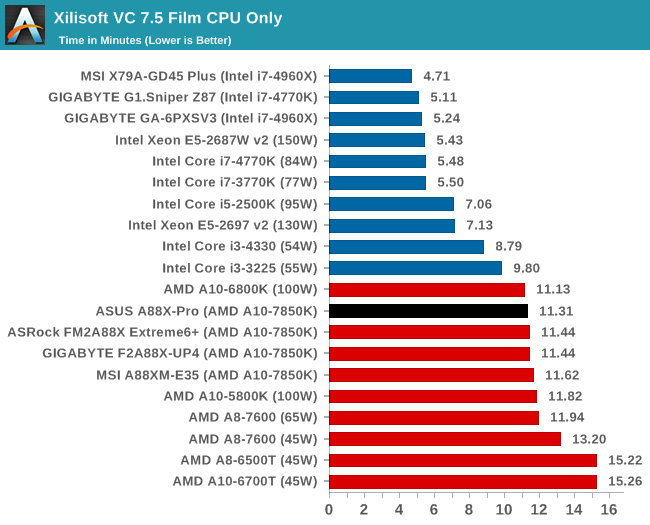
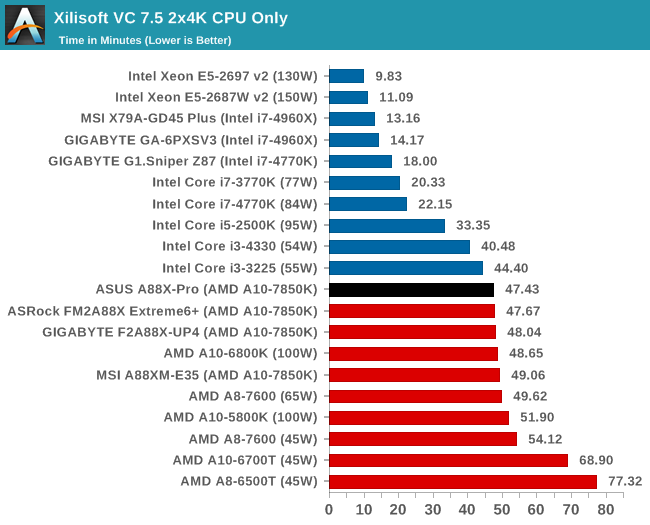
Video Conversion – Handbrake v0.9.9: link
Handbrake is a media conversion tool that was initially designed to help DVD ISOs and Video CDs into more common video formats. The principle today is still the same, primarily as an output for H.264 + AAC/MP3 audio within an MKV container. In our test we use the same videos as in the Xilisoft test, and results are given in frames per second.
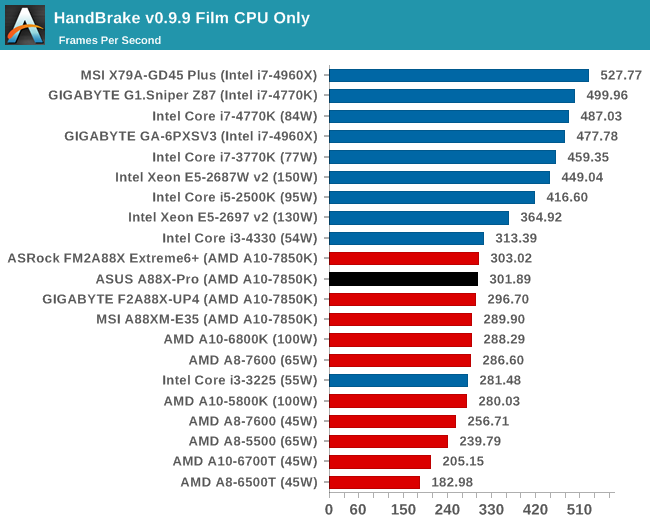

Rendering – PovRay 3.7: link
The Persistence of Vision RayTracer, or PovRay, is a freeware package for as the name suggests, ray tracing. It is a pure renderer, rather than modeling software, but the latest beta version contains a handy benchmark for stressing all processing threads on a platform. We have been using this test in motherboard reviews to test memory stability at various CPU speeds to good effect – if it passes the test, the IMC in the CPU is stable for a given CPU speed. As a CPU test, it runs for approximately 2-3 minutes on high end platforms.
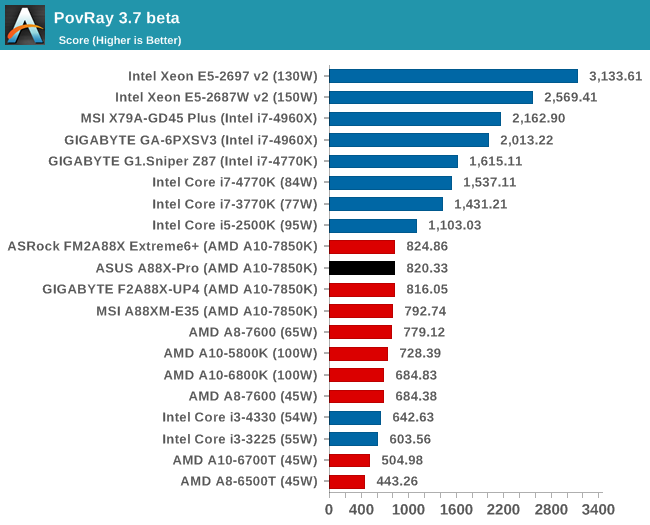










34 Comments
View All Comments
duploxxx - Tuesday, April 22, 2014 - link
hmm, lets see in results with mid lvl gpu its actually very close to the intel ones. Other cpu benchmarks are pure synthetic and useless for daily tasks or observations. so yeah you are right there is no usecase for narrow minded peopleBucky_Beaver - Tuesday, April 22, 2014 - link
Hmm so Adobe After Effects are useless for daily tasks or observations? Good to know, I guess..CHADBOGA - Tuesday, April 22, 2014 - link
Yeah the best way to judge a CPU's performance, is clearly in a GPU limited benchmark.coburn_c - Tuesday, April 22, 2014 - link
AMD doesn't care about black processors. erm.. performance... AMD doesn't care about performance processors. So I no longer care about AMD. Sad day but like with an addict you have to draw a tough line.The_Assimilator - Tuesday, April 22, 2014 - link
There is one feature that might cause someone to buy an AMD system over Intel - namely, 8x SATA3 ports vs's Intel's 6. So what does ASUS do? They go and waste two of those ports on eSATA. Good job ASUS designers, do you know what would be even better? A D-SUB connector in 2014... oh wait.Alexvrb - Wednesday, April 23, 2014 - link
The eSATA ports are way more useful to me than a couple of extra internal connectors, especially in a pedestrian FM2+ configuration. This isn't meant for a server. There are other FM2+ boards if you are building a NAS or home server. I have never needed that many internal drives on any regular user-facing box (again, not a server).fteoath64 - Thursday, April 24, 2014 - link
Great points!. Yes, 8 sata internal connectors would be a great way to go as many users would want a home server NAS system. However, here is one opportunity where AMD is missing. Getting into that market with several Kaveri variants that has far more value that Gpu grunt and HSA features. It is power savings and using heterogenous cores. Picture this, a Kaveri with 2 SR cores and 4 puma cores with ability for SR cores to be powered off! And all GCN but one core active at low power (eg 200MHz). This is the NAS mode and should not pull more than 25w TDP. So while gaming, one SR core pushes 4.5Ghz, second SR core doing 3.6Ghz while puma cores running 2.5Ghz doing I/O and caching. We really want dynamic TDP adjustment at the BIOS level to manage the system.abufrejoval - Tuesday, April 22, 2014 - link
In these days of "device" craze, it's easy to forget what a PC is all about: Expandability!And what these boards offer are mainly slots: Lots of usable, unhampered, wide slots, which you can use for everything that fits inside!
Not just graphics!
Ok, so you ask: "What's there that still needs to be fit, when everything is already on-board?"
And I say: "Things to come, things which aren't commodity yet!"
And since that's my job, evaluating these things for our corporate data centers, that's what I do: Play around with (what used to be) new stuff like FusionIO, 10Gbit Ethernet, GPU compute etc.
And in that environment I've come to like these AMD APU boards with plenty of wide slots and ports as well as IOMMU support, lots of RAM capacity and mostly even with ECC support.
I run them in my home lab taking the "goods" like FusionIO SSDs, 10GB NICs etc. temporarily from my corporate test lab to my home lab, where experimenting is often a lot faster, with open cases under my desk instead of rack-mount servers inside the computer room.
But I also use them to run as ordinary home servers, where 8 SATA ports, plenty of RAM, good-enough CPU and GPU also allow for very flexible yet quiet servers I an afford to run 24x7 on my home power bill.
They are very, very flexible, which of course also means they aren't perfect at anything: They aren't the lowest power or highest performing systems which I'd need and use in *production*. But when you want "Lego"-like flexibility to try things out, they are really great and very affordable.
And now I'm ready to start with my griping:
AFAIK there are none of the stupid (well actually Intel would think them smart...) limitations that Intel's chipsets have on AMD's platform: Where Intel used to give you only 16 usable PCIe lanes off the CPU, but only allowed you to use them for a GPU (early Intel variants shut off on-board graphics if you inserted a PCIe x8 RAID controller into the CPU slot!) AMD never knew such restrictions. On Intel such things as "bifurication", which is nothing but splitting the 16 lanes into two pairs of 8x, are *luxury* you need to pay at least by going to a Z-chipset, or if you actually would like to combine it with VT-D aka IOMMU best with a C-chipset, of course only combinable with server CPUs.
I'll save you the gory details on the Intel side, most likely you are painfully aware of them anyway.
But with AMD, AFAIK, these limitations do not exist: You can put plenty of 16x slots on your board and while the total number of lanes is of course also fixed by what the CPU/APU supports, the allocation to slots and integrated devices is pretty flexible: The more cards you actually insert, the lower the number of lanes per slot. On the other hand with PCIe 3.0 even a single lane is rather OK for a 10Gbit NIC.
Yet I find that with these FM2+ board, which should not suffer the Intel restrictions, those very same restrictions are *replicated*!
Please correct me if I am wrong, but I believe there is no reason, why you shouldn't be able to buy an FM2+ board with 3x PCIe x16 slots, which should work with 8/8/4 PCIe 3.0 out of the box (perhaps 8/4/4 3.0, which still beats the pants off most entry level Intel offerings): Yet you simply can't have it, unless you go to one of these "Pro" boards.
On the Intel side, yes the 100% price uplift vs. entry would be "justified" by having to resort to some sort of PLX PCIe bridge, but on AMD?
On the Intel side, yes, the 3rd slot would be "not recommended" for anything requiring serious bandwidth, because no matter what how many lanes or what speed you'd see at the slot, it would still have to pass through a 4x PCIe 1.0 bottleneck between CPU and what's left of the South Bridge.
But for an AMD board to down-grade to PCIe 2.0 or even 1.0 on the 3rd slot seems more like "feature emulation" than a technical requirement!
So why is there this "Pro" price gap, "emulating" a similar gap on the Intel side, *when there is no reason beyond marketing?*
Of course I understand why ASUS and their fellow competitors are doing this, but could Anandtech kindly expose that nonsense and discreetly step on some toes?
I don't actually mind paying a little premium to have more usable 16x PCIe slots as well as a generally higher quality motherboard.
But since my use case isn't trying to emulate an Intel 2011 based gaming rig on the the cheap, I'm not nearly as concerned about overclocking as I am about idle power consumption or plain old stability (and that would include ECC support, please, pretty please!)
And on these "Pro" motherboards everything screams about "burn but don't melt" not about "cool and will last forever".
And Anandtech not mentioning power consumption even with a single word, leads me to believe that whoever is using these boards, doesn't have power efficiency on his mind. I've achieved 18Watts on idle desktop using Richmond APUs on ASUS motherboards and I think that's "allright" even if Intel's BayTrail SoCs can scratch 10 Watts off that score. 40+ Watts, however, would signal a resounding "no-go".
Acceptable power efficiency is *exactly* why I'd by one of these: The ability to replace a DL980 class server for quite a few of my virtualization, solid state storage and SDN experiments, while it delivers a home-server and even a 24x7 desktop including some "shoot-them-up" before signing off.
Yes it wouldn't be best at anything, but it would a do a darn good job at replacing quite a few "optimal" systems for the things I do: Great value for an affordable price!
mikato - Wednesday, April 23, 2014 - link
Wow, I completely agree. Nice comment. I remember getting 2 full x16 PCI express lanes on my motherboard, and plenty of SATA connectors when I built my Phenom II X4 965 machine. I told a couple friends who built Intel and they were surprised. Well, Intel is artificially limiting things for price segmentation power, that's just the way it is.mattgmann - Tuesday, April 22, 2014 - link
Dear AMD, Intel, Nvidia and to whomever else this may concern.Please come up with new naming schemes for your motherboards/chipsets/processors/gpus etc. The practice of enumerating your products very closely to that of your competitors is stupid. And though you may claim it to be coincidence, or just following your historic naming schemes, your are lying.
It is not a coincidence that Intel offers the Z87, and AMD the A88X. I am too many scotches deep to provide more examples in this rant, but they abound. It's a crappy marketing practice and just a sign of lazy and uncreative work in their respective departments.
P.S. If any of these companies would like help giving their products creative, attractive names that their intended clientele can relate to, such as "Under the desk dustbox Xtreme", "Mom's basement Earthquake Generator", "Better than apple in an Ironic way (hipster edition)", or perhaps "Extra Core Overcompensator (AMD special)"... Please feel free to contact me, or one of my minions.